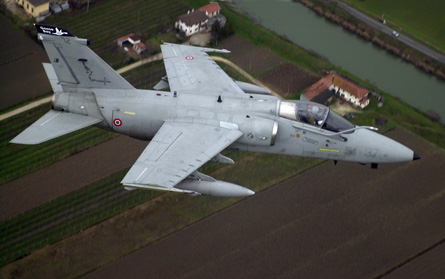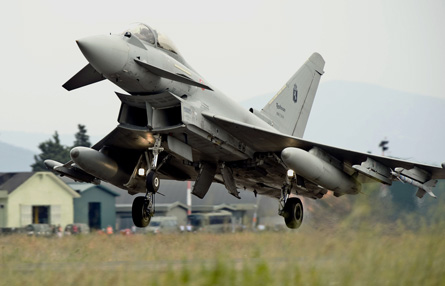The Italian air force could face a near-term degradation of its capabilities - and these could include a cut to its combat and training aircraft fleets because of a rapid and dramatic contraction to its training, maintenance and operational funding.
Air force deputy chief-of-staff Gen Giuseppe Bernadis says Rome's three-year defence budget law for 2009-11 "could have dramatic results on operational capabilities if additional funding, such as that approved in 2009 by the Parliament for out-of-area operations, isn't added in the following budget years".
He adds: "If further contractions in the operational resources continue, we see the concrete risk to dismiss one frontline aircraft component, possibly the [Alenia Aeronautica/Embraer] AMX."
 |
|---|
© Troupe Azzurra/Italian air force |
Italy currently flies around 65 AMX strike aircraft
The service's training assets are also likely to be affected, with this only partially compensated by the use of simulators. Bernadis says that the spending reduction trend could require short-term reduction of the Alenia Aermacchi MB-339 fleet, which would also affect the Frecce Tricolori display team. However, the Galatina flying school has been converted to attract international customers, and Bernadis says cadets from Algeria and Greece could undergo instruction this year.
The air force's command and support infrastructure was reorganised last year. This concentrated combat aircraft and air defence batteries under one command; transport aircraft, search-and-rescue and combat SAR forces in another; and special forces and ground protection units, including a dedicated special forces support helicopter unit, in a third.
In the past three years, the air force has reduced its annual flying hours from more than 116,000 to just below 87,500 in 2008. And based on the latest budget reductions, it envisages operating two combat types in the medium to long term, with around 100 each of the Eurofighter Typhoon and Lockheed Martin F-35 Joint Strike Fighter.
"The current [Panavia] Tornado and AMX fleets, respectively of around 95 and 65 aircraft, will be progressively reduced by 2014 to 50 aircraft in each component. These will be gradually replaced in the following years by the JSF," Bernadis says.
Around 60 conventional take-off and landing F-35As and 40 short take-off and vertical landing F-35Bs will be acquired, with the latter variant to be fielded first to re-equip two AMX squadrons, he adds.
As regards Italy's programme commitment to buy 121 Eurofighters, Bernadis says: "The fundamental point of reference is our fixed price cap. Within this limit we expect to be able to acquire around 100 aircraft, which will have primary air defence and secondary air-to-ground capabilities." The type now provides round-the-clock air defence cover from Gioia del Colle and Grosseto air bases, and Tranche 3 contract negotiations continue also involving Germany, Spain and the UK.
 |
|---|
© Geoffrey Lee/Eurofighter |
Rome's Eurofighter commitment could decrease to around 100 aircraft
In the transport sector, "the long-delayed delivery of the first or couple of [four] Boeing 767 tankers is expected to actually begin at the end of 2009", Bernadis says. Air force crews are preparing for the type's delayed availability using a 767 provided at no cost by Boeing. The service will also by mid-year receive its last of 12 Alenia Aeronautica C-27Js, with the tactical transport having made a successful operational debut in Afghanistan between September 2008 and January 2009.
General Atomics Predator A unmanned air vehicles have logged over 4,250 flight hours in Afghanistan and Iraq, and are now being upgraded. "We expect to receive the first of four Predator Bs by the end of 2009," Bernadis says, with initial operational capability to be declared in 2010 with three aircraft.
Meanwhile, an agreement was recently made with air traffic control and safety agencies to expand controlled areas and flight corridors for UAVs in Italy. This will gradually allow unmanned platforms to fly between Amendola and Decimomannu air bases, expanding training activities and providing maritime surveillance, Bernadis says.
The defence ministry is meanwhile looking to replace the air force's lone Alenia Aeronautica G222VS signals intelligence aircraft with two new intelligence, surveillance and reconnaissance platforms, which Bernadis says will be "based on [Gulfstream] G550 aircraft". Dubbed the joint airborne multi-sensor multi-mission system, the acquisition is awaiting parliamentary approval.
Four ATR 72MP maritime patrol aircraft are already on order to replace some of the service's Dassault-Breguet ATL-1 Atlantics by 2012. However, these are considered gap-fillers pending the arrival of a more capable platform.
Another important acquisition centres on recapitalising the air force's CSAR/SAR helicopter component. "The contract for the first two CSAR-equipped AgustaWestland AW101s with new engines, avionics and self-protection capabilities is expected to be awarded by the end of 2009," says Bernadis, with 12 to be delivered by 2014. A proposed lease arrangement to replace its Agusta-Bell AB212s with AW139/149s is also under "detailed evaluation", he says.
All contracts for new aircraft will include the provision of on-site maintenance and support services for at least a five-year period, Bernadis notes, "to prevent following budget axes".
The air force's next purchase is likely to be a pending deal for 15 Alenia Aermacchi M-346 advanced jet trainers, which Bernadis expects to be finalised in the first half of this year. Italy will be the first customer for the type, also recently selected by the United Arab Emirates for a 48-aircraft requirement.
Source: Flight International



















